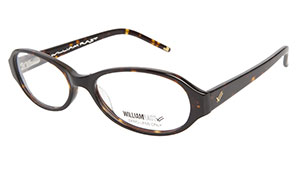
|
Upon receiving his frames, the gentleman—again, politely—requested that he be given the opportunity to purchase a new pair. As he’d been advised would be the case, his lenses turned out not only incredibly thick, but the edges were so chunky that they actually prevented the temples from closing!
Rectangular frames are the perpetual thorn-in-the-side and perpetual blessing of the dispensary. On one hand, they’ve become the P3 for a new era, generic, basic frames that can suit just about any face—even those shorter, rounder faces for whom the once ubiquitous round frames weren’t cosmetically flattering. On the other, taken from a functionality standpoint, they’re not for everyone: High myopes fare incredibly poorly from the blocky, chunky edges created by rectangular frames, and particularly sensitive patients can sometimes pick up on edge distortion even in lower Rx's.

William Rast WR1016 Tortoise, Image: Coastal.com |
Why the dearth, then? It’s a chicken and the egg question: You’ll be hard pressed to find many oval shapes from frame manufacturers; you’re also probably not getting many requests from patients, either. As a result, the few ovals on the market represent a narrow variety of proportions not suited to every patient face, and those who do try the style out often find themselves unimpressed with what they see in the mirror.
I believe it’s time for a minor revolution of sorts: The return of the oval frame. With its versatility and classic styling, the oval deserves to be given a second chance in this new era of optical eye-wareness, another opportunity to demonstrate its usefulness to wearers. I believe through sufficient education on the optical end and attractive enough designs offered by frame manufacturers, we can reinvigorate this once proud icon while doing right by our patients, aesthetically as well as functionally.












